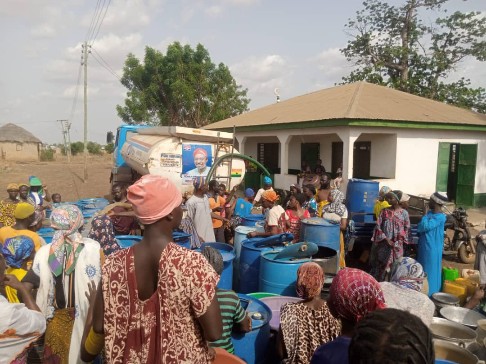Goodbye To Maize & Soya-Beans


The crisis-hit poultry sub-sector of the agricultural mixed bag in Ghana is largely due to the shortage and the high cost of poultry feed. The traditional sources of feed are overstretched and this continues to threaten poultry in Ghana. This rubs off the other factors affecting poultry production in Ghana. The void created out of low productivity has been filled with imports, and the local poultry breeder is much poorer.

The sources of poultry feed are mainly corn or imported yellow corn, soybean cake, cotton-seed cake, copra cake, soybean meal, and fish meal; vitamin-mineral premixes are generally imported. Most of the imported feeds are taxed, and the cost of corn in Ghana is also ever-rising. Faced with ugly noises within the sector about the shortage of poultry feed, the government banned soya exports in 2022.
The challenges have wagged the tail of Ghanaian scientists, particularly those at the Council for Scientific and Industrial Research, CSIR, who have triggered their uncanny sixth senses to find solutions. The ground-breaking alternatives devised by agricultural research scientists include the improvement of existing yellow corn varieties with technologies such as stress-tolerant crop varieties and the worm feeds generated from the blackfly and the housefly. The latter is labeled proteinaceous, exotic nutrition for livestock while avoiding issues concerning the availability of land for soya and maize cultivation. The pilot is already a success, yet it is not in widespread use.

Whilst those whose mettle commits them to innovation are at it, a businessman who wants to free his operations from the leash also took a giant step to create a difference as far as poultry breeding is concerned. Mr. Bempong Adom told GhanaReport that ingenuity can be cultivated in two ways. First, by learning from books and traveling to live the experiences of others.
In poultry, he has departed from the norm of raising fowls and his breeds are not the type familiar to the Ghanaian. In his stocks are birds of different genetic make-up, substantially different from the layers and the broilers raised by most Ghanaian poultry farmers.
Broiler Chickens with enormous meat are crossed with native birds from the US state of Arizona, and the Republic of India

An indigenous chicken from Arizona
The Kuroiler chicken is a class of poultry called genetically improved birds and it originated in India. The Kuroiler chickens were derived by cross-breeding colored broiler males and the Rhode Island Red females. The result was the dual-purpose Kuroiler chicken breeds which can be reared for both meat and eggs. Learning about these from books, the peripatetic businessman Mr. Bempong Adom moved to locations where these special breeds were raised. One of the places he visited was Uganda where he consulted a Kuroiler breeder who had made in-roads in the business.

The giant chicken breed called Kuroiler
Among the qualities of Kuroiler chickens are fast maturity, a higher number of eggs, a longer laying period, and a fast maturity rate of only 10 weeks.
By the age of maturity, your Kuroiler chickens will weigh as much as 3.5 kg with very minimal input on your side. By incorporating a slightly improved semi-free range technique and a little bit of commercial feeding, you will be able to multiply your Kuroiler flock in a very short period of time and you will be on your way to making millions with very few investments in the first place.
Mr. Bempong Adom stressed that while the lifetime egg cycle of the layer bird is only about 50, the Kuroiler bird lay averages 140. Ain’t you on your way to becoming a millionaire? The picture above shows some of the corks at his poultry farm called Farming Academy located at Kwabeng in the Atiwa West district in the Eastern region of Ghana. The hens are pictured just below.
You do not need to spend a lot of money in order to feed Kuroiler birds. You can only supplement their scavenging with some commercial feeding in order to boost production but they will do just as well if they have a large grazing area. They are to put weight faster and produce more eggs in tough conditions.
The boon for this type of poultry is in the feeds. Mr. Bempong Adom feeds his stocks with cassava, watermelons, bananas, aloe vera plants, pawpaw, and other greens. In the case of aloe vera, it is mashed and mixed with water to feed the poultry. He said, his livestock has improved tremendously from these feeds as the birds hardly suffer any illness.
Kuroilers beak ground cassava
Kuroiler Feeds

The Kuroiler is voracious on watermelons
Watermelon, one of the nutritious fruits grown in Ghana, is currently in abundance in parts of the country. Although that is good news for consumers, the same cannot be said for farmers of the produce. In the North East Region for instance, where a chunk of the fruit is produced, farmers are worried, as they incur massive losses due to low patronage.
In the North East Region of Ghana for instance, where a chunk of the fruit is produced, farmers are worried, as they incur massive losses due to low patronage. Unfortunately, this has been their story for many years each time the fruit is in abundance.
Farmers, comprising the youth and women, derive their incomes from this activity. But due to a lack of a ready market, a lot of the product usually goes bad, and the farmers lose their investments.
The Founder of Farming Academy at Kwabeng, Mr. Bempong Adom has shown the way that this chicken breed called Kuroiler will readily jump at the menu stated above, including watermelon which has only a small market in the country with producers awaiting the establishment of a watermelon-based fruit juice company in the north to stem post-harvest losses. Even the disused parts of freshly used fruits such as bananas and pawpaw are not wastes to Kuroiler poultry farms.
Dressed Kuroiler
Kuroiler meat is served in a popular local eatery at Kwabeng opposite the Kwabeng Anglican Senior High and Technical school. It is in the direction of Bomaa and Tekyiman in that catchment area. The owner of Farming Academy which has 4,000 birds, says he intends to make supplies to grocery shops, supermarkets, foreign embassies, hotels and restaurants, and local eateries, and for export. The poultry farm is named an academy because it intends to lift the youth out of poverty through training, though livestock husbandry is capital-intensive. Already, he is constructing an apartment for his workers, in what he described as a strategic step for greater organization.
He is also thinking of soliciting the support of international organizations and governments which directly offer assistance to private agricultural ventures for expansion and training.
Below is a photograph of Mr. Bempong Adom, the Founder of Farming Academy. He has shown the way by obviating the soya and corn meal burden for poultry in Ghana. He is also into the production of the Soursop plant for other uses.





